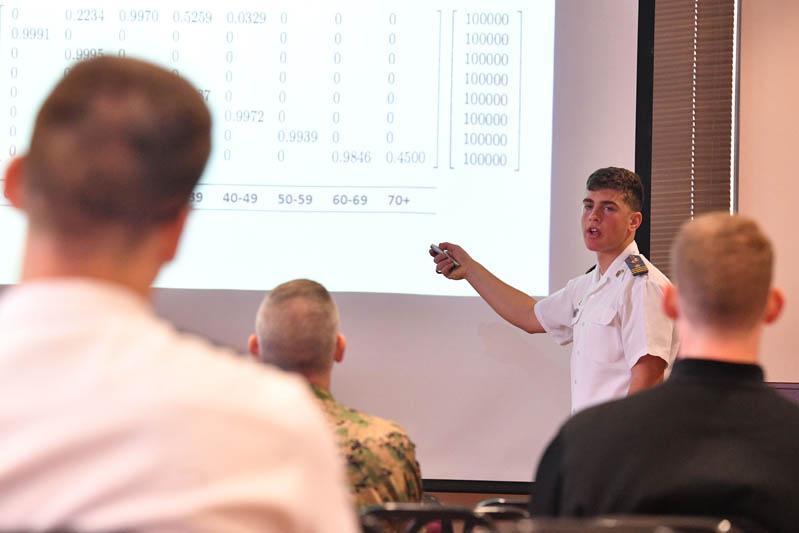Honors Thesis Explores Population Dynamics

Drew Borinstein ’17 presents his honors thesis in the Turman room of Preston Library on the effects of declining birthrates in the U.S. on March 28. – VMI Photo by H. Lockwood McLaughlin.
LEXINGTON, Va., April 19, 2017 – Drew Borinstein ’17 has spent much of the past year digging into a real-world problem that’s likely to have serious implications in the decades ahead – the declining U.S. birthrate.
Borinstein, an applied math major who plans to commission in the Marine Corps, recently presented his honors thesis, “A quantitative examination of the effects of declining birthrates on the U.S. population and their respective implications,” during Honors Week, held March 27-31.
Borinstein’s interest in the topic of population dynamics was sparked when he received an audio book, The Next 100 Years: a Forecast for the 21st Century, as a Christmas present in December 2015. The book’s author, George Friedman, discusses population trends and predicts that by the middle of this century, the U.S. government will be paying people to move here because current birthrates cannot supply the population needed to support the projected workforce.
Working with Lt. Col. Meagan Herald, associate professor of applied mathematics, Borenstein developed a research proposal to explore the impact of the falling U.S. birthrate. Along the way, he received help from not only Herald, but also Col. Troy Siemers, professor of mathematics, and Col. Sam Allen, professor of economics and business.
In his honors week presentation, Borinstein explained that in order for a population to remain stable, each woman needs to give birth to 2.1 children. However, the current U.S. birthrate is only 1.86 children per woman. In 1911, by contrast, the birthrate was just below 3.5 children per woman.
“[This trend] poses a threat to the U.S. economy and workforce,” noted Borinstein. He added that ultimately, if nothing is done, a labor gap will emerge, in which there are not enough workers to fill available jobs.
To study this trend, and possible remedies for it, Borinstein used a modeling tool called a Leslie matrix. “The matrix predicts the total number in each of the age classes in the future,” Borinstein stated. “The Leslie matrix, when you just multiply it times the initial population, it tells us what that population is going to look like in 10 years.”
Thanks to the Leslie matrix, Borinstein found that while populations have for centuries been represented by a pyramid, with the greatest number of people in the youngest category and the smallest in the oldest age category, the U.S. population is currently in a block shape, with roughly equal age distributions.
Eventually, as the younger generations shrink, there will not be enough workers to support the projected number of retirees, threatening Social Security, Medicare, and other government programs.
In his work, Borinstein explored four possible remedies for this looming crisis: increasing the retirement age, relying more on technology to make labor more productive, using economic incentives to encourage more births, and incentivizing immigration.
“Realistically, I think it’s going to be a combination of the four,” said Borinstein. “None of them work independently.”
Of those four, though, immigration – though a hot-button issue in the current political climate – offers the most hope for real change, Borinstein acknowledged, as immigrants tend to have more children. “If we bring in an extra 10 million immigrants like we did in the decade of the 2000s, we could easily fill the projected labor gap that we’ll have,” he stated.
Shortly after Borinstein’s honors thesis presentation, he and Herald traveled to Asheville, North Carolina, where Borinstein presented his research at the Southern Regional Honors Conference. “Drew did an excellent job among the other presenters,” noted Herald.
“I enjoyed it a lot,” said Borinstein of his presentation at the conference. “They wanted me to condense it down to 15 minutes, and I had to sort of rush toward the end, but I got a very good response from the audience – a lot of compliments and a lot of questions.”
Herald had high praise for Borinstein’s work.
“He’s done really, really well,” she said. “Research has its ups and downs, and he recovered very well from the downs – very quickly, very efficiently. He’s learned to change and adapt and move on.”
- Mary Price
-VMI-
.svg)
.png)